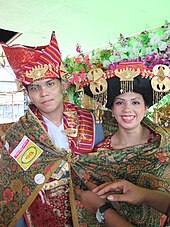Karo people (Indonesia)
[5] In 1911, an agricultural project began at Berastagi, now the major town in Karoland, to grow European vegetables in the cooler temperatures.
Berastagi is today the most prosperous part of Karoland, just one hour from Medan, while towns further in the interior suffer from lower incomes and limited access to healthcare.
In the 13th to 16th century, the Karo people established the Aru Kingdom (also spelled Haru), located in modern-day Medan City and Deli Serdang Regency.
The successor state of the Aru Kingdom was the Sultanate of Deli, which demonstrated a mixed influence of Karo, Malay, Tamil, and Aceh.
However, an increasing number of people living away from the Karo Highlands have converted to Islam, with the influence of Muslim Malay from the neighboring Deli area in Medan and Javanese immigrants, thus reducing the prevalence of the customs of pig farming and cooking.
[9] In recent times, the inclusion of Karo people with other Batak subgroups, is increasingly becoming controversial due to cultural and linguistic differences.
The Netherlands Missionary Society answered the call, commencing activities in the Karolands in 1890, where they engaged not only in evangelism but also in ethnology and documenting the Karo culture.
The missionaries attempted to construct a base in Kabanjahe in the Karo highlands but were repelled by the suspicious locals.
In retaliation, the Dutch administration waged a war to conquer the Karolands, as part of their final consolidation of power in the Indies.
At this time, the Balai Pustaka Adat Merga Si Lima (BPAMSL) was established in Berastagi.
BPAMSL conducted a ceremony in the Lau Debuk–Debuk hot spring akin to the one to invest in a new Karo village.
At that time, BPAMSL became the largest religious organisation in the Karolands, surpassing the GBKP, and absorbing many who had joined it following the anti-Communist purge.
With BPAMSL no longer a united force for the practice of Pemena, and Pemena itself no longer a uniting force in the Karoland, and with all Indonesians required to follow one of the religions of Islam, Protestantism, Catholicism, Hinduism, Buddhism, or risk writing 'without belief' on their identity card, the board members of BPAMSL met with a wealthy Indian man from Medan and determined that the traditional religion was, in fact, an expression of Indian Hinduism and that it had been founded by a 'Bagavan Bṛgu', from which had been derived the alternate name for the Karo beliefs 'Perbegu' (followers of 'begu' (in Karo, begu is a spirit or ghost)), the existence of Indian-originating Karo marga names and similarities between Karo ritual and Indian Hindu ones all proving this.
This left the Christian GBKP, by then for many years an indigenous Karo-run adat-respecting church a rather more comfortable option for most Karo than the Balinese Hinduism asserted by PHDK.
There are today four Balinese-style PHDK temples in the Karoland, but the concept of Karo traditional beliefs as a manifestation of Hinduism is otherwise largely extinct.
Karo people belong to one of five marga or clans, which are Ginting, Karo-Karo, Perangin-Angin, Sembiring, and Tarigan.
Karonese marriages are very large affairs, with typically 200 attendees, comprising the numerous family members of both marrying parties, comprising several elements, including the chewing of betel nut (sirih), traditional Karonese dancing (which focuses on hand movements), the payment of a nominal dowry to each of the kalimbubu.
Non-Karo people do not attend the wedding ceremony, although such friends might be invited to a separate party in the evening.
[3] Karo tradition states that the Merga si Lima originate from five villages, each established by a Sibayak, a founding community.







